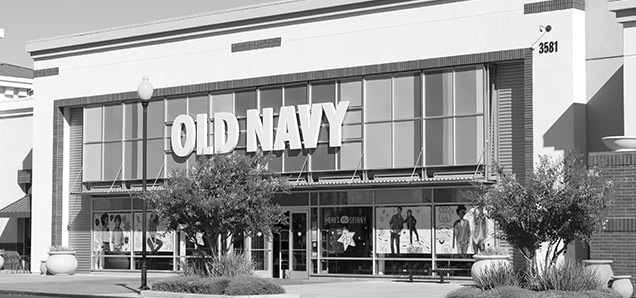Plus-size women second-class citizens
 CREDIT: SNYFEROK/ISTOCK EDITORIAL/THINKSTOCK
CREDIT: SNYFEROK/ISTOCK EDITORIAL/THINKSTOCKFashion retailer Old Navy does carry plus-sized clothing, but a lot of it is hidden in the back.
If you’ve ever shopped at a big brand store that sells both plus and straight sizes, you may have asked the question, “Where are the plus sizes?” They’re hidden in the back of the store or tucked away on the second floor of the store. Why? Because fat isn’t cool.
If a store actually carries plus sizes, a plus-size woman must consider herself lucky that the store would even cater to her. Many clothing companies actually refuse to sell plus size clothing such as; Abercrombie & Fitch and Lululemon to name a few.
Robin Lewis, co-author of The New Rules of Retail, says Mike Jeffries, CEO of Abercrombie & Fitch’s mindset is a reason for a lack of plus-sized clothing in his store.
“He doesn’t want his core customers to see people who aren’t as hot as them wearing his clothing,” Lewis said. “People who wear his clothing should feel like they’re one of the ‘cool kids.’”
While the average woman’s dress size is 14, Abercrombie & Fitch’s size offering for women does not go past a size 10. Lululemon offers up to a size 12, but former employees have stated that the largest sizes – size 10 and 12 – are relegated to a separate area at the back of the store, left clumped and unfolded under a table.
Chip Wilson, CEO of Lululemon, has a reason for not going past a size 12.
“It takes 30 per cent more fabric to create plus-size clothes, meaning he would have to charge a higher price for them.” Wilson says that was something he would never do. “Plus-size people are sensitive, and the company would feel intense fallout from the community.”
Sensitive? That’s a pretty broad generalization of an entire community of women.
While it does take 30 per cent more material, the reasoning is flawed. It requires far more material to create a size eight pair of pants, as opposed to a size zero, but there is no price difference.
Why must a plus-size woman pay more? Why must a plus-size woman be forced to scour the back of the store, or the bottom of the pile, like a second-class citizen?
In a report run by the NDP Group, 56 per cent of plus-size women say that it is hard finding plus-size clothing with the same level of quality as regular-size clothing and yet, plus-size clothing is ridiculously marked up.
Retailers can treat plus-size woman this way, because they have few alternatives. In the same report, 63 per cent of plus-size women reported that shopping for plus-size clothing is more stressful than shopping for regular-size clothing, and 62 per cent said that they have trouble finding plus-sized clothing styles they want.
Brands like Old Navy – that offer both straight and plus-sizes – often only go up to a size 18 in stores, forcing any customer that is “too big” to shop online, rather than gracing their stores. Old Navy also charges its female plus-size customers $10 to $15 more for jeans, while plus-size men do not experience the same markup.
Old Navy says that the increase in price is a result of “unique fabrics and flattering design elements.” But these unique fabrics and flattering design elements are also included in the straight-sized clothing.
Although there are brands that specialize in plus-size clothing, these brands are also guilty of overcharging their customers. To buy a basic black T-shirt in a store like Penningtons, the price ranges from $24 to $26.
At high-end plus size retailers like Addition Elle, the price of a basic T-shirt can range to almost $40. For prices like that, it’s expected that the quality would be amazing, however, it is no different than the cheaply made clothing offered by Old Navy. Only 39 per cent of women report that they prefer to buy from a brand that specialized in plus-size clothing.
Plus-size women don’t want to be segregated from straight-sized women, forced to shop at a special store, because regular stores won’t sell to them. They want equality, fair prices and better styles. Plus-size women are not second-class citizens.
Plus-size fashion is a $14 billion industry. Fashion retailers, show some respect.
Editorial opinions or comments expressed in this online edition of Interrobang newspaper reflect the views of the writer and are not those of the Interrobang or the Fanshawe Student Union. The Interrobang is published weekly by the Fanshawe Student Union at 1001 Fanshawe College Blvd., P.O. Box 7005, London, Ontario, N5Y 5R6 and distributed through the Fanshawe College community. Letters to the editor are welcome. All letters are subject to editing and should be emailed. All letters must be accompanied by contact information. Letters can also be submitted online by clicking here.













